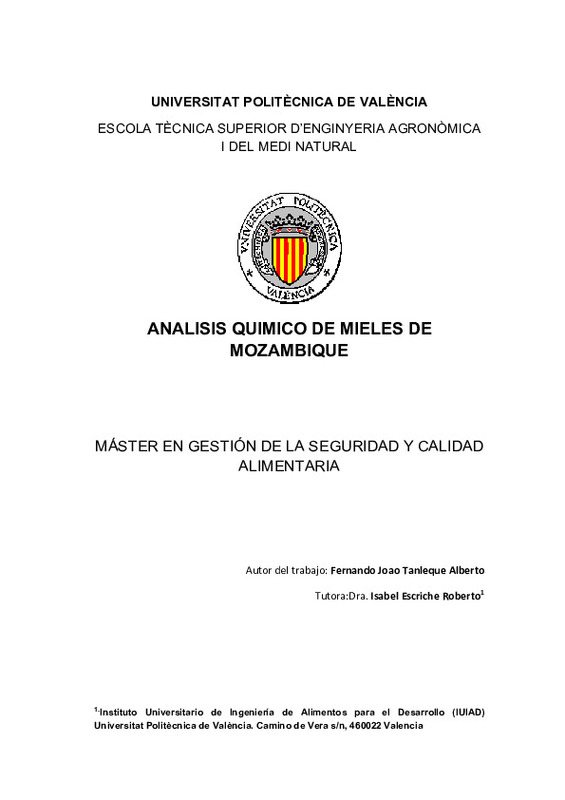JavaScript is disabled for your browser. Some features of this site may not work without it.
Buscar en RiuNet
Listar
Mi cuenta
Estadísticas
Ayuda RiuNet
Admin. UPV
Análisis químico de mieles de Mozambique
Mostrar el registro sencillo del ítem
Ficheros en el ítem
| dc.contributor.advisor | Escriche Roberto, Mª Isabel
|
es_ES |
| dc.contributor.author | Alberto, Fernando Joâo Tanleque
|
es_ES |
| dc.date.accessioned | 2015-07-17T11:21:41Z | |
| dc.date.available | 2015-07-17T11:21:41Z | |
| dc.date.created | 2015-06-30 | |
| dc.date.issued | 2015-07-17 | es_ES |
| dc.identifier.uri | http://hdl.handle.net/10251/53414 | |
| dc.description.abstract | [EN] Mozambique, located on the east coast of Africa, is a developing country with great potential in terms of the availability of agro-ecological resources. It has a great diversity of climate, vegetation and geographic regions. This results in a variety of melliferous flora that can be exploited throughout the year by transhumance. Beekeeping in rural areas of Mozambique provides food for families and could serve to complement their income. There is an almost total lack of scientific data concerning the characteristics of honey from Mozambique. Therefore, the objective of this study was to evaluate the physicochemical characteristics, colour, sugar composition and the aromatic fraction of honey from different areas of Mozambique (Nampula, Sofala y Zambezia). The ANOVA results showed that honey from the three regions differed significantly in relation to HMF, moisture, electrical conductivity, aw and Pfund colour, but not with respect to the content of major sugars (fructose, glucose and sucrose). With regard to the volatile fraction, statistical differences were found between geographic regions for 14 of the 35 compounds identified. A multivariate analysis (PCA) of these compounds permitted differentiation of the honey samples according to their origin. Mozambique honey from the three areas under study have different characteristics in relation to the presence of volatile compounds; either due to an abundance of them (e.g. Nampula), or the presence of some specific compounds, especially aldehydes such as Butanal and Butanal 2-methyl (e.g. Sofala) | es_ES |
| dc.description.abstract | [ES] El trabajo consiste en el estudio de la fracción volátil de mieles procedentes de tres regiones de Mozambique. El análisis de las muestras se ha llevado a cabo por purga y trampa y GC-MS. Se ha observado determinados compuestos específicos de las diferentes zonas geográficas relacionados con la flora presente en ellas. | es_ES |
| dc.language | Español | es_ES |
| dc.publisher | Universitat Politècnica de València | es_ES |
| dc.rights | Reserva de todos los derechos | es_ES |
| dc.subject | Geographical origin | es_ES |
| dc.subject | Physicochemical characteristics | es_ES |
| dc.subject | Volatile compounds | es_ES |
| dc.subject | Mozambique honey | es_ES |
| dc.subject | Miel | es_ES |
| dc.subject | Volátiles | es_ES |
| dc.subject | Mozambique | es_ES |
| dc.subject.classification | TECNOLOGIA DE ALIMENTOS | es_ES |
| dc.subject.other | Máster Universitario en Gestión de la Seguridad y Calidad Alimentaria-Màster Universitari en Gestió de la Seguretat i Qualitat Alimentària | es_ES |
| dc.title | Análisis químico de mieles de Mozambique | es_ES |
| dc.type | Tesis de máster | es_ES |
| dc.rights.accessRights | Abierto | es_ES |
| dc.contributor.affiliation | Universitat Politècnica de València. Escuela Técnica Superior de Ingeniería Agronómica y del Medio Natural - Escola Tècnica Superior d'Enginyeria Agronòmica i del Medi Natural | es_ES |
| dc.contributor.affiliation | Universitat Politècnica de València. Departamento de Tecnología de Alimentos - Departament de Tecnologia d'Aliments | es_ES |
| dc.description.bibliographicCitation | Alberto, FJT. (2015). Análisis químico de mieles de Mozambique. http://hdl.handle.net/10251/53414. | es_ES |
| dc.description.accrualMethod | TFGM | es_ES |
| dc.relation.pasarela | TFGM\28306 | es_ES |
Este ítem aparece en la(s) siguiente(s) colección(ones)
-
ETSIAMN - Trabajos académicos [3541]
Escuela Técnica Superior de Ingeniería Agronómica y del Medio Natural






